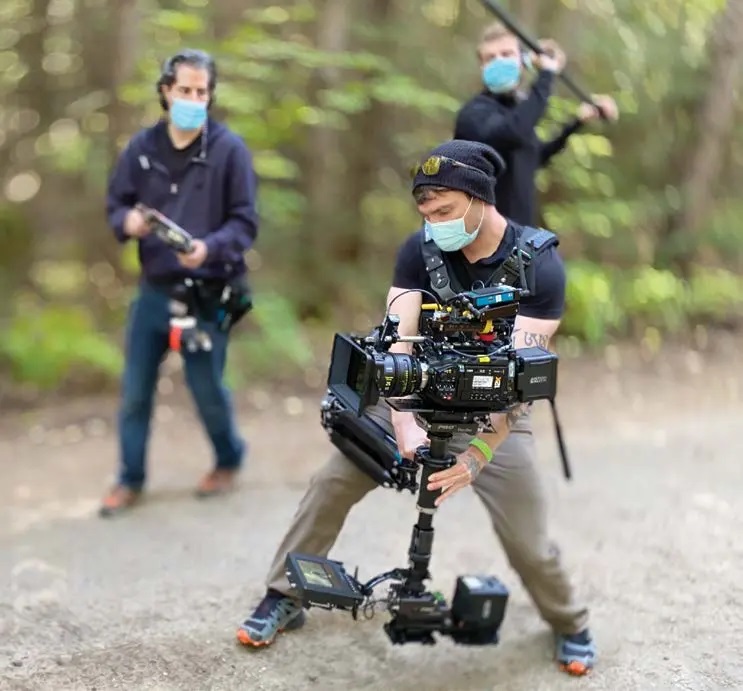8K Is Already Transforming Video Production
Few consumers own 8K sets but producers are already successfully using 8K technologies to improve TV, film, event and sport production

The 2022 NAB Show features a host of new technologies likely to transform the industry in the next decade, including demonstrations of new equipment and technologies for stunning 8K video, which offers 16 times the resolution of HD and four times the resolution of 4K.
“If you have ever viewed immersive 8K content, especially paired with phenomenal audio, it is an experience that is unmatched,” said Hugo Gaggioni, CTO, Sony Electronics, Imaging Products and Solutions Americas — Professional, which supplies the Venice 2 camera and other equipment that is being used in 8K productions.
Most people are unlikely to have that experience anytime soon, however. Only 1 million 8K TVs were sold globally in 2021, according to Strategy Analytics, which is predicting that about 72 million households worldwide will have an 8K set in 2025, a tiny fraction of the 1.7 billion homes with TV sets in the world.
“We are still in the early days of 8K,” said Bob Caniglia, director of sales operations, Americas at Blackmagic Design, which is showing the Blackmagic URSA Mini Pro 12K and other 8K-capable technologies at the show.
But Caniglia, Sony’s Gaggioni and others who are showing 8K-capable equipment are quick to add that there are already many appealing use cases for 8K in virtual productions, post-production, virtual reality, replays, events and other areas where the content may end up being shown in 4K or even HD.
Multicamera film productions needing very high resolution for CG and virtual productions, for example, are two promising illustrations of how 8K technologies can be utilized today, explained Charlie Dunn, senior vice president, Telestream.
LIMITED EARLY ADOPTION
The professional video industry's #1 source for news, trends and product and tech information. Sign up below.
Currently, 8K content offerings are extremely limited, with some streaming services like YouTube TV and Roku and some broadcasters, mainly in Japan and China, regularly offering 8K video.
“Our 8K cameras are used for major sporting events, music programs, and are broadcast live on Japan’s NHK BS8K [an 8K satellite channel],” said Hiroshi Akiyama, marketing executive at Ikegami Tsushinki Co., which is showing its fourth generation of 8K cameras.
In addition to NHK producing about 200 hours of 8K video during the Summer Olympics in Tokyo, Chinese broadcasters have also embraced the format. “A leading Chinese broadcaster officially launched an 8K channel early last year and went live for 8K production for major events like the … Winter Olympics,” added Xuan Zhang, product manager, Matrox Video, which supplied cards and a CDV graphic system for 8K UHD graphics.
There have also been some notable efforts to make it easier to create and distribute 8K content.
“A Leader LV5900 HD/4K/8K multistandard waveform monitor was chosen to monitor the signal feed of an hour-long, live 8K broadcast by BT from Northampton England to Amsterdam,” said Moriharu Ide, president of Leader Instruments Corp.
“During the Olympics we saw HEVC 8K [content delivered and] encoded at 85 Mpbs,” said Thierry Fautier, vice president of video strategy at Harmonic, which is an active member of the 8K Association and has supplied equipment for 8K productions. “With more modern software-based encodes we can go below 40 Mbps as was demonstrated during the 2019 French Open tennis tournament” that used Harmonic technologies.
THE FUTURE IS NOW
More importantly, 8K technologies are playing a growing role in efforts to improve the way HD, HDR and 4K content is produced today.
“We are already seeing a lot of 8K and even 12K in virtual production,” said Caniglia at Blackmagic Design. “The extra resolution you get on LED walls gives you more detail and allows you to shoot in higher resolution.”
Another promising application is in live sports. “For live sport, 8K cameras or higher can be used to provide a panoramic view of a stadium, which can be cropped in software to the lower resolutions used today in broadcast,” said David Mitchinson, head of strategic initiatives at Appear. This provides a panoramic view that can be cropped to follow an individual player and is ideal for remote productions because it requires no camera movement.
Producers are also increasingly using 8K to shoot action scenes because the higher resolution allows them to reframe shots in post-production.
“Users are choosing [Sony’s] Venice 2 8K camera because of the image quality and [they] may shoot in 8K because of the flexibility in post-production,” added Gaggioni at Sony. “We have seen many productions down res to 4K or 5.7K and still use the VENICE 2-inch camera from Sony.
Creating 8K masters protects the long-term value of content that might be distributed in HD or 4K today, vendors say. “Content producers will inevitably advance from HD and 4K-UHD to 8K to maximize the shelf life of their programs,” said Ide at Leader Instruments.
Copyright NAB Show Daily
George Winslow is the senior content producer for TV Tech. He has written about the television, media and technology industries for nearly 30 years for such publications as Broadcasting & Cable, Multichannel News and TV Tech. Over the years, he has edited a number of magazines, including Multichannel News International and World Screen, and moderated panels at such major industry events as NAB and MIP TV. He has published two books and dozens of encyclopedia articles on such subjects as the media, New York City history and economics.

